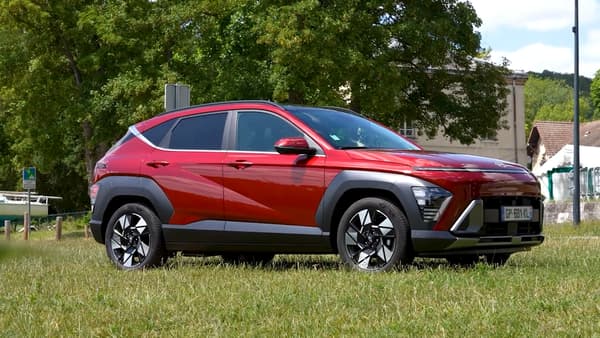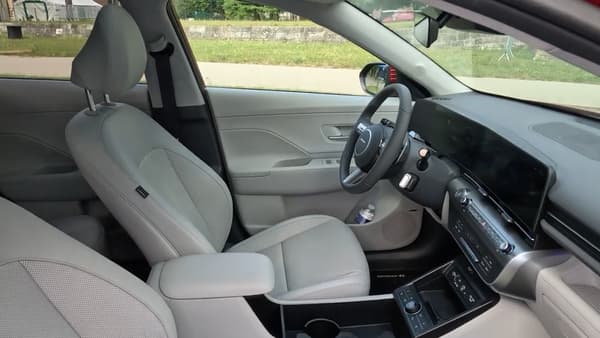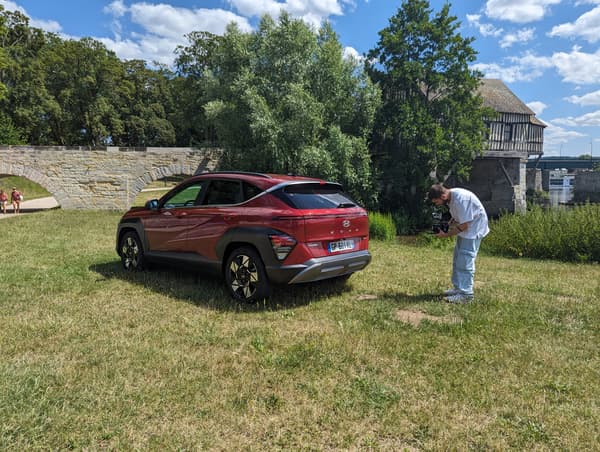Hyundai continues to move upmarket. This year, the Korean brand launches the second generation of its compact SUV, the Kona. A model that was launched in 2017 and was very successful in Europe and in France in particular.
More modern and bigger.
Although we recognize it well, especially for its imposing protections on the wheel arches, the Kona is still transformed with its new design. Especially with this long strip of light on the front which gives it a very modern look. A headband that you can also find on the back of this new version.

The other big change is in terms of its dimensions, 15 centimeters longer in length to 4.35 meters, compared to the 4.20 meters of the previous one, which of course benefits the space on board, but also the volume of the trunk. 25% larger with 466 liters.
In fact, the idea is to better distinguish this Kona in the range of Hyundai SUVs, between a smaller Bayon, 4.18 meters, and the Tucson, 4.50 meters.
A very “grainy” interior, why not?
The change is also quite spacious inside, with a cabin similar to that of Hyundai’s latest Ioniq models. A very pleasant space with this white leather interior and the practicable roof that brings a lot of light on board.

The gear selector (to activate forward, reverse, neutral or the handbrake) is located on the steering wheel, freeing up space in the center console, with plenty of storage space.
There are also a lot of physical buttons, a bit against the current trend of very refined interiors. Enough to attract those who don’t really like using the touch screen to activate different functions.
As for the digital interfaces, a double touch screen stands out in the center and the instrument screen behind the steering wheel, with two 12.3-inch panels.
The charm of the hybrid
Faced with a version, Hyundai launches its new Kona in a non-rechargeable hybrid version, which combines a 105-horsepower gasoline engine with a 43-horsepower electric motor. The latter is connected to a small 1.56 kWh battery. A reduced displacement that does not really allow 100% electric driving, but rather during low-speed maneuvers or accompanying the internal combustion engine during acceleration phases.

Other advantages of this small battery are its fairly limited weight and the ability to recharge quickly by recovering energy when braking. Il est d’ailleurs possibile d’adjuster le level de freinage régénératif grâce à des palettes au volant, pratique pour passer d’un mode roue libre à du “one-pedal” (il suffit de relâcher la pédale d’accélérateur pour ralentir fortement vehicle).
Enough to gain comfort for this vehicle that also improves its maneuverability and acoustic insulation on board.
During our test, having traveled just over 130 km between highways, secondary roads and the city, we consumed 5.7 liters per 100 kilometers. A fairly honorable score considering the size of this new Kona.
A price that also increases, but with more options
This Hyundai Kona hybrid has a starting price of 33,400 euros: an entry price that is increasing sharply, but which in terms of equipment corresponds to the third trim level of the previous generation.
Therefore, we find many valuable options as standard, such as adaptive cruise control or front and rear parking assistance.
For our test model in executive finish we must have a price of 39,900 euros.
This hybrid version should especially appeal to customers of the older generation Tucson diesel, who had not upgraded to the latest Tucson hybrid with a significant price difference. Let’s see if this model will be able to convert them into a first level of electrification that is quite low in gasoline consumption.
Source: BFM TV

